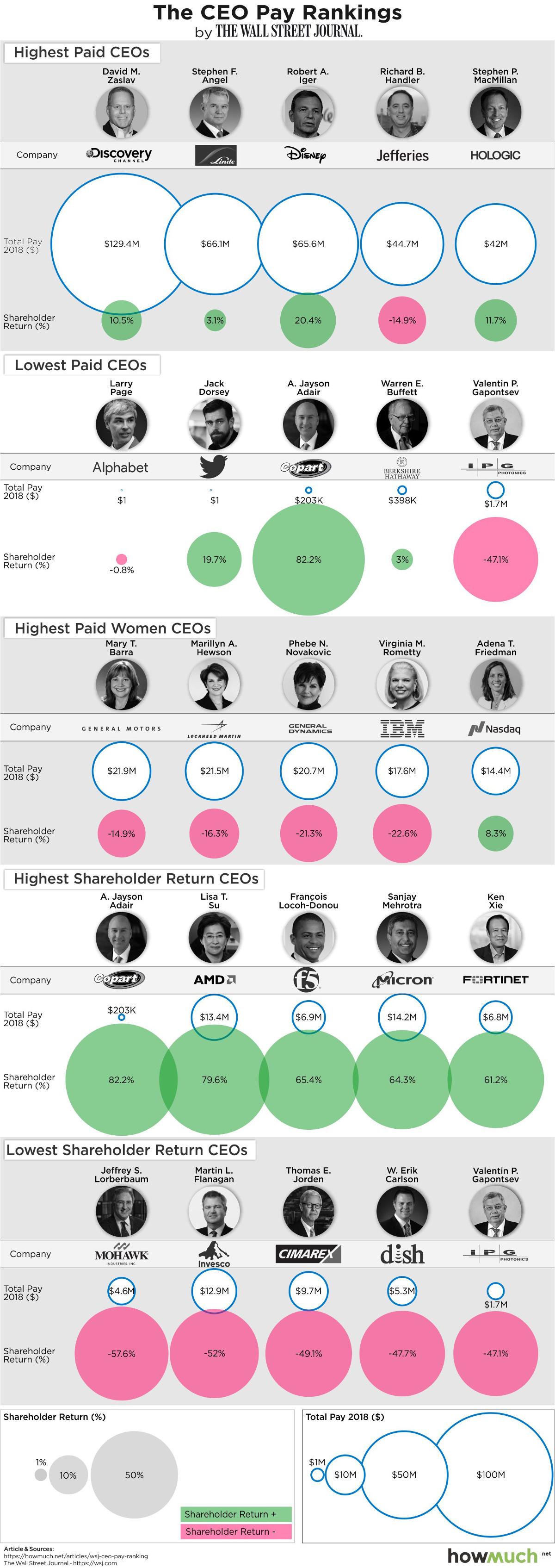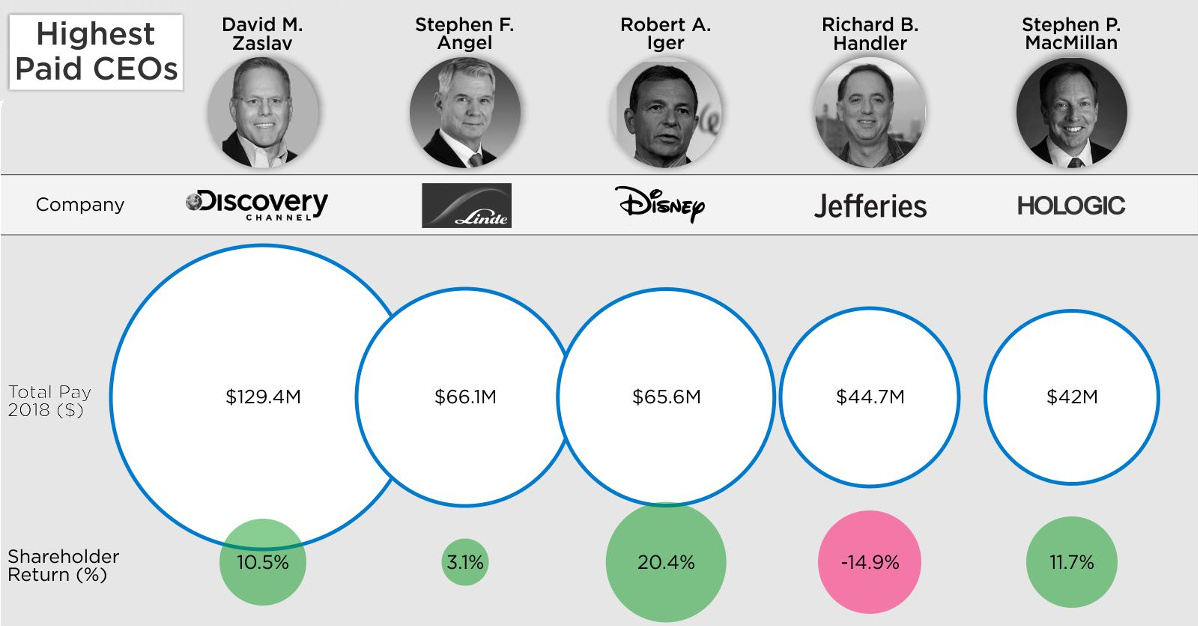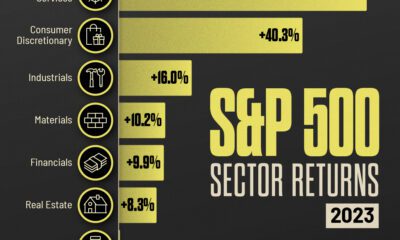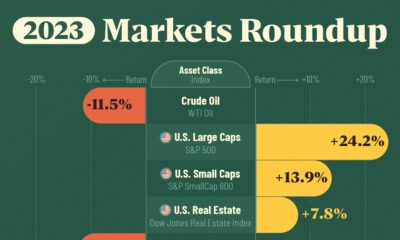Markets
Here’s How Much the Top CEOs of S&P 500 Companies Get Paid

How Much the Top CEOs of S&P 500 Companies Get Paid
How much do the CEOs from some of the world’s most important companies get paid, and do these top CEOs deliver commensurate returns to shareholders?
Today’s infographic comes to us from HowMuch.net and it visualizes data on S&P 500 companies to see if there is any relationship between CEO pay and stock performance.
For Richer or Poorer
To begin, let’s look at the highest and lowest paid CEOs on the S&P 500, and their associated performance levels. Data here comes from a report by the Wall Street Journal.
Below are the five CEOs with the most pay in 2018:
| Rank | CEO | Company | Pay (2018) | Shareholder Return |
|---|---|---|---|---|
| #1 | David Zaslav | Discovery, Inc. | $129.4 million | 10.5% |
| #2 | Stephen Angel | Linde | $66.1 million | 3.1% |
| #3 | Bob Iger | Disney | $65.6 million | 20.4% |
| #4 | Richard Handler | Jefferies | $44.7 million | -14.9% |
| #5 | Stephen MacMillan | Hologic | $42.0 million | 11.7% |
Last year, David Zaslav led top CEOs by taking home $129.4 million from Discovery, Inc., the parent company of various TV properties such as the Discovery Channel, Animal Planet, HGTV, Food Network, and other non-fiction focused programming. He delivered a 10.4% shareholder return, when the S&P 500 itself finished in negative territory in 2018.
Of the mix of highest-paid CEOs, Bob Iger of Disney may be able to claim the biggest impact. He helped close a $71.3 billion acquisition of 21st Century Fox, while also leading Disney’s efforts to launch a streaming service to compete with Netflix. The market rewarded Disney with a 20.4% shareholder return, while Iger received a paycheck of $65.6 million.
Now, let’s look at the lowest paid CEOs in 2018:
| Rank | CEO | Company | Pay (2018) | Shareholder Return |
|---|---|---|---|---|
| #1 | Larry Page | Alphabet | $1 | -0.8% |
| #2 | Jack Dorsey | $1 | 19.7% | |
| #3 | A. Jayson Adair | Copart | $203,000 | 82.2% |
| #4 | Warren Buffett | Berkshire Hathaway | $398,000 | 3.0% |
| #5 | Valentin Gapontsev | IPG Photonics | $1.7 million | -47.1% |
On the list of lowest paid CEOs, we see two tech titans (Larry Page and Jack Dorsey) that have each opted for $1 salaries. Of course, they are both billionaires that own large amounts of shares in their respective companies, so they are not particularly worried about annual paychecks.
Also appearing here is Warren Buffett, who is technically paid $100,000 per year by Berkshire Hathaway plus an amount of “other compensation” that fluctuates annually. While this is indeed a modest salary, the Warren Buffett Empire is anything but modest in size – and the legendary value investor currently holds a net worth of $84.3 billion.
Finally, it’s worth noting that while J. Jayson Adair of Copart was one of the lowest paid CEOs at $203,000 in 2018, the company had the best return on the S&P 500 at 82.2%. Today, the company’s stock price still sits near all-time highs.
Maxing Returns
Finally, let’s take a peek at the CEOs that received the highest shareholder returns, and if they seem to correlate with compensation at all.
| Rank | CEO | Company | Pay (2018) | Shareholder Return |
|---|---|---|---|---|
| #1 | A. Jayson Adair | Copart | $203,000 | 82.2% |
| #2 | Lisa Su | AMD | $13.4 million | 79.6% |
| #3 | François Locoh-Donou | F5 Networks | $6.9 million | 65.4% |
| #4 | Sanjay Mehrotra | Micron Technology | $14.2 million | 64.3% |
| #5 | Ken Xie | Fortinet | $6.8 million | 61.2% |
Interestingly, three of highest performing CEOs – in terms of shareholder returns – actually took home smaller amounts than the median S&P 500 annual paycheck of $12.4 million. This includes the aforementioned A. Jayson Adair, who raked in only $203,000 in 2018.
That said, there is a good counterpoint to this as well.
Of the five CEOs who had the worst returns, four of them made less than the median value of $12.4 million, while one remaining CEO took home slightly more. In other words, both the best and worst performing CEOs skew towards lower-than-average pay to some degree.
Markets
The European Stock Market: Attractive Valuations Offer Opportunities
On average, the European stock market has valuations that are nearly 50% lower than U.S. valuations. But how can you access the market?

European Stock Market: Attractive Valuations Offer Opportunities
Europe is known for some established brands, from L’Oréal to Louis Vuitton. However, the European stock market offers additional opportunities that may be lesser known.
The above infographic, sponsored by STOXX, outlines why investors may want to consider European stocks.
Attractive Valuations
Compared to most North American and Asian markets, European stocks offer lower or comparable valuations.
| Index | Price-to-Earnings Ratio | Price-to-Book Ratio |
|---|---|---|
| EURO STOXX 50 | 14.9 | 2.2 |
| STOXX Europe 600 | 14.4 | 2 |
| U.S. | 25.9 | 4.7 |
| Canada | 16.1 | 1.8 |
| Japan | 15.4 | 1.6 |
| Asia Pacific ex. China | 17.1 | 1.8 |
Data as of February 29, 2024. See graphic for full index names. Ratios based on trailing 12 month financials. The price to earnings ratio excludes companies with negative earnings.
On average, European valuations are nearly 50% lower than U.S. valuations, potentially offering an affordable entry point for investors.
Research also shows that lower price ratios have historically led to higher long-term returns.
Market Movements Not Closely Connected
Over the last decade, the European stock market had low-to-moderate correlation with North American and Asian equities.
The below chart shows correlations from February 2014 to February 2024. A value closer to zero indicates low correlation, while a value of one would indicate that two regions are moving in perfect unison.
| EURO STOXX 50 | STOXX EUROPE 600 | U.S. | Canada | Japan | Asia Pacific ex. China |
|
|---|---|---|---|---|---|---|
| EURO STOXX 50 | 1.00 | 0.97 | 0.55 | 0.67 | 0.24 | 0.43 |
| STOXX EUROPE 600 | 1.00 | 0.56 | 0.71 | 0.28 | 0.48 | |
| U.S. | 1.00 | 0.73 | 0.12 | 0.25 | ||
| Canada | 1.00 | 0.22 | 0.40 | |||
| Japan | 1.00 | 0.88 | ||||
| Asia Pacific ex. China | 1.00 |
Data is based on daily USD returns.
European equities had relatively independent market movements from North American and Asian markets. One contributing factor could be the differing sector weights in each market. For instance, technology makes up a quarter of the U.S. market, but health care and industrials dominate the broader European market.
Ultimately, European equities can enhance portfolio diversification and have the potential to mitigate risk for investors.
Tracking the Market
For investors interested in European equities, STOXX offers a variety of flagship indices:
| Index | Description | Market Cap |
|---|---|---|
| STOXX Europe 600 | Pan-regional, broad market | €10.5T |
| STOXX Developed Europe | Pan-regional, broad-market | €9.9T |
| STOXX Europe 600 ESG-X | Pan-regional, broad market, sustainability focus | €9.7T |
| STOXX Europe 50 | Pan-regional, blue-chip | €5.1T |
| EURO STOXX 50 | Eurozone, blue-chip | €3.5T |
Data is as of February 29, 2024. Market cap is free float, which represents the shares that are readily available for public trading on stock exchanges.
The EURO STOXX 50 tracks the Eurozone’s biggest and most traded companies. It also underlies one of the world’s largest ranges of ETFs and mutual funds. As of November 2023, there were €27.3 billion in ETFs and €23.5B in mutual fund assets under management tracking the index.
“For the past 25 years, the EURO STOXX 50 has served as an accurate, reliable and tradable representation of the Eurozone equity market.”
— Axel Lomholt, General Manager at STOXX
Partnering with STOXX to Track the European Stock Market
Are you interested in European equities? STOXX can be a valuable partner:
- Comprehensive, liquid and investable ecosystem
- European heritage, global reach
- Highly sophisticated customization capabilities
- Open architecture approach to using data
- Close partnerships with clients
- Part of ISS STOXX and Deutsche Börse Group
With a full suite of indices, STOXX can help you benchmark against the European stock market.

Learn how STOXX’s European indices offer liquid and effective market access.

-

 Economy3 days ago
Economy3 days agoEconomic Growth Forecasts for G7 and BRICS Countries in 2024
The IMF has released its economic growth forecasts for 2024. How do the G7 and BRICS countries compare?
-

 Markets2 weeks ago
Markets2 weeks agoU.S. Debt Interest Payments Reach $1 Trillion
U.S. debt interest payments have surged past the $1 trillion dollar mark, amid high interest rates and an ever-expanding debt burden.
-

 United States2 weeks ago
United States2 weeks agoRanked: The Largest U.S. Corporations by Number of Employees
We visualized the top U.S. companies by employees, revealing the massive scale of retailers like Walmart, Target, and Home Depot.
-

 Markets2 weeks ago
Markets2 weeks agoThe Top 10 States by Real GDP Growth in 2023
This graphic shows the states with the highest real GDP growth rate in 2023, largely propelled by the oil and gas boom.
-

 Markets3 weeks ago
Markets3 weeks agoRanked: The World’s Top Flight Routes, by Revenue
In this graphic, we show the highest earning flight routes globally as air travel continued to rebound in 2023.
-

 Markets3 weeks ago
Markets3 weeks agoRanked: The Most Valuable Housing Markets in America
The U.S. residential real estate market is worth a staggering $47.5 trillion. Here are the most valuable housing markets in the country.
-

 Science1 week ago
Science1 week agoVisualizing the Average Lifespans of Mammals
-

 Markets2 weeks ago
Markets2 weeks agoThe Top 10 States by Real GDP Growth in 2023
-

 Demographics2 weeks ago
Demographics2 weeks agoThe Smallest Gender Wage Gaps in OECD Countries
-

 United States2 weeks ago
United States2 weeks agoWhere U.S. Inflation Hit the Hardest in March 2024
-

 Green2 weeks ago
Green2 weeks agoTop Countries By Forest Growth Since 2001
-

 United States2 weeks ago
United States2 weeks agoRanked: The Largest U.S. Corporations by Number of Employees
-

 Maps2 weeks ago
Maps2 weeks agoThe Largest Earthquakes in the New York Area (1970-2024)
-

 Green2 weeks ago
Green2 weeks agoRanked: The Countries With the Most Air Pollution in 2023















